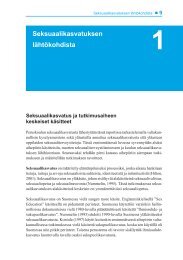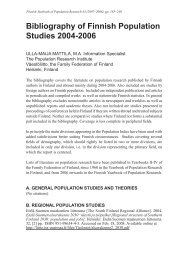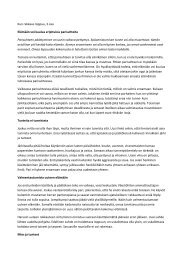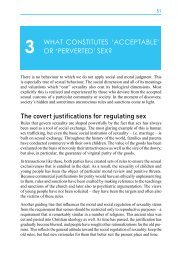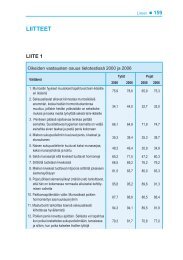Early History of the Oral Contraceptive Pill in Finland ... - Väestöliitto
Early History of the Oral Contraceptive Pill in Finland ... - Väestöliitto
Early History of the Oral Contraceptive Pill in Finland ... - Väestöliitto
Create successful ePaper yourself
Turn your PDF publications into a flip-book with our unique Google optimized e-Paper software.
56<br />
1976–1980 <strong>the</strong> median age for women enter<strong>in</strong>g <strong>the</strong>ir first marriage had risen to 23.3<br />
years and 25.2 for men. Simultaneously cohabitation was becom<strong>in</strong>g <strong>in</strong>creas<strong>in</strong>gly<br />
popular (L<strong>in</strong>dgren 1979; Miett<strong>in</strong>en 2005, 194; Statistics F<strong>in</strong>land 1967b, 53; Statistics<br />
F<strong>in</strong>land 1978, 60–62; see also van de Kaa 1997, 10).<br />
It is specific for <strong>the</strong> F<strong>in</strong>nish context that <strong>the</strong> proponents <strong>of</strong> <strong>the</strong> new values emphasized<br />
<strong>the</strong> role and <strong>the</strong> activity <strong>of</strong> <strong>the</strong> state <strong>in</strong> ensur<strong>in</strong>g that <strong>the</strong>ir goals could be met. They set<br />
various responsibilities for <strong>the</strong> public sector related to such fields as education and<br />
health (Taipale 1966). The discussion on gender roles, sexuality, and contraception<br />
began to turn <strong>in</strong>to actions at <strong>the</strong> beg<strong>in</strong>n<strong>in</strong>g <strong>of</strong> <strong>the</strong> 1970s. Many <strong>of</strong> <strong>the</strong> aims orig<strong>in</strong>ally<br />
formulated by <strong>the</strong> social movements had become objectives <strong>of</strong> <strong>the</strong> ris<strong>in</strong>g welfare state.<br />
As mentioned, dur<strong>in</strong>g <strong>the</strong> 20 th century <strong>in</strong>dividual’s reproductive potential had been first<br />
viewed ma<strong>in</strong>ly from <strong>the</strong> perspective <strong>of</strong> <strong>the</strong> population and <strong>the</strong> nation, <strong>the</strong>n from <strong>the</strong><br />
viewpo<strong>in</strong>t <strong>of</strong> <strong>the</strong> family. In <strong>the</strong> third phase, more attention was given to <strong>the</strong> <strong>in</strong>dividual<br />
and his or her <strong>in</strong>dividual wants and needs. Sexuality and <strong>the</strong> control <strong>of</strong> reproduction<br />
became <strong>in</strong>creas<strong>in</strong>gly viewed as important <strong>in</strong>dividual rights, which <strong>the</strong> state was assumed<br />
to guarantee and promote (Helén & Yesilova 2003, 245–248). This also meant that <strong>the</strong><br />
authorities were assumed to provide <strong>the</strong> services needed <strong>in</strong>stead <strong>of</strong> non-governmental<br />
organizations (Ritamies 2006, 255).<br />
Medical pr<strong>of</strong>essionals were at <strong>the</strong> center <strong>of</strong> <strong>the</strong> changes related to fertility control. In<br />
approximately one decade a notable attitud<strong>in</strong>al shift took place among F<strong>in</strong>nish doctors.<br />
Many <strong>of</strong> <strong>the</strong>m had adopted a ra<strong>the</strong>r liberal stance towards contraception by <strong>the</strong><br />
end <strong>of</strong> <strong>the</strong> 1960s though still <strong>in</strong> 1968 doctors were more <strong>of</strong>ten will<strong>in</strong>g to give family<br />
plann<strong>in</strong>g counsel<strong>in</strong>g when asked by married women (n<strong>in</strong>e out <strong>of</strong> ten) than by those<br />
who were not married (two out or three). From <strong>the</strong> different methods available, <strong>the</strong><br />
doctors already preferred <strong>the</strong> pill (Turpe<strong>in</strong>en 1968; Warpenius 1997). By <strong>the</strong> mid-1970s<br />
an <strong>in</strong>dividual’s right to family plann<strong>in</strong>g counsel<strong>in</strong>g and to abortion had been consolidated<br />
<strong>in</strong> laws. The new Act on Induced Abortion (239/1970) – <strong>in</strong> which abortion was<br />
legalized on social grounds – and <strong>the</strong> Primary Health Care Act (66/1972) established<br />
<strong>the</strong> practices <strong>in</strong>to <strong>the</strong> health care system <strong>of</strong> <strong>the</strong> welfare state. Both <strong>of</strong> <strong>the</strong>se practices<br />
had become thoroughly medicalized.<br />
When <strong>the</strong> Act on Induced Abortion (239/1970) came <strong>in</strong>to force, <strong>the</strong> amount <strong>of</strong> legal<br />
abortions rose substantially. In 1973 more than 23,000 abortions were recorded (Stakes<br />
2004). For comparison, <strong>in</strong> <strong>the</strong> same year <strong>the</strong> number <strong>of</strong> births was slightly below<br />
57,000 (Statistics F<strong>in</strong>land 2011a). The rapid rise <strong>in</strong> abortion rates paved <strong>the</strong> way for<br />
<strong>the</strong> <strong>in</strong>troduction <strong>of</strong> a law on contraception services. The activists <strong>of</strong> social movements,<br />
<strong>the</strong> FPFWF, authorities, and doctors were all able to agree that contraception was a<br />
better and more acceptable way to limit fertility than abortion. However, no separate<br />
law on contraception was ever enacted. Instead, contraception counsel<strong>in</strong>g was <strong>in</strong>cluded<br />
<strong>in</strong> <strong>the</strong> Primary Health Care Act (66/1972) aimed to renew patchy primary health care.



